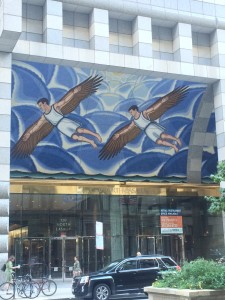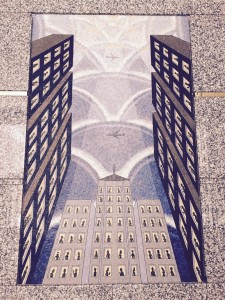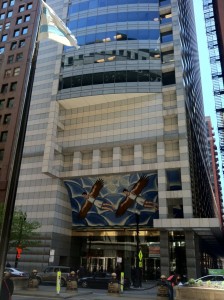Above the doorway at 120 North La Salle Street a mosaic depicts Daedalus, together with his son Icarus, soaring high in the sky on the wax wings he designed and built. Inside the lobby a second mosaic presents jet planes flying above the Chicago Loop’s epicenter. They seem to celebrate Chicago as a site of age-old technological dreams realized. But that is not the whole story.
The pair of mosaics adorn a striking 40-story contemporary office facing the neoclassical Chicago City Hall and a very short way down the street from the financial district where the Board of Trade and a number of significant modern and neoclassical buildings sit nearly side by side.
These two mosaics by Chicago Imagist artist Roger Brown comment on an extraordinary feature of this corner of the city that Brown expressly adored — the way neoclassical and modernist architectural gems coexist in harmony on a block dense with notable buildings. In Brown’s view, this coexistence powerfully expressed a democratic principle. He representation of this principle into the compositions. The subject of the exterior mosaic gestures toward the classical yet its design is modern and playful. The glass mosaic materials have an ancient pedigree yet the work is placed in a shiny metal and glass entranceway.
Brown’s use of myth might also suggest more philosophical thought about the permanence of the human struggle to combine art and technology, as well as its delights and dangers. The compositions of both the exterior and interior mosaics evoke the pleasures that attach to human creativity applied to concrete needs. In one, Daedalus and Icarus are in flight against a bright blue sky and in the light of the sun. In the other, lively figures populate every window facing the sky in which the planes fly.
The mosaics also compare ancient and modern manifestations of hubris, possibly cautioning the technologically sophisticated industrialists whose headquarters were very nearby as well as the occupants of City Hall across the street and all Chicagoans and visitors. Explanatory plaques prepared by the artist affixed to the walls make this explicit. One provides details of the myth including an account of how Icarus plummets to the ground and perishes as a result of having ignored his father’s instructions not to fly too close to the hot sun in wings made of wax. The other lauds Chicago’s leading role in technological achievement but also draws attention to the “holding pattern” in which the planes circle above Chicago.
The explanatory plaques on site read:
Arts and Science of the Ancient World
THE FLIGHT OF DAEDALUS AND ICARUS
In Greek mythology, Daedalus, the great architect, inventor, and sculptor, built the world famous Labyrinth to confine the half-man, half-bull Minotaur in the Crete for King Minos. When Theseus was to be sent to his doom at the hands of the Minotaur, Ariadne, the daughter of Minos approached Daedalus to ask him to devise a means of escape for Theseus whom she loved. After Theseus had killed the Minotaur and escaped, King Minos imprisoned Daedalus and his son Icarus to the Labyrinth. The great architect made wings for each of them. Before they took flight, the father warned his son to fly the middle course. Icarus ignored his father’s warning and flew too high. The sun melted the wax which held the wings together and he fell in the sea. Daedalus however flew the middle course and reached the other shore.
Arts and Sciences of the Modern World
LASALLE CORRIDOR WITH HOLDING PATTERN
In the modern world, Chicago represents great achievements in architecture and in the other arts and sciences as well. The goddess Ceres stands atop the Board of Trade building at the end of LaSalle Street watching over the “city of big shoulders.” On the other side of the street, classical Greek facades of older buildings harmonize with the technology of newer ones. At any moment a plan may be seen circling overhead waiting its turn to land at O’Hare Field… the former myth of human flight now a reality. Daedalus, the mythological architect, may have felt at home here. He certainly foreshadowed the art of technology that brought this beautiful city into being.
View an episode of “Ask Geoffrey” on Chicago Public Television WTTW’s “Chicago Tonight” program from July 23, 2014 about Brown’s “The Flight of Daedalus and Icarus.”
Both mosaics were commissioned by Ahmansion Commercial Development Company, a subsidiary of Home Savings of America, and the architectural firm Murphy/Jahn Architects. They were dedicated on July 29, 1991. The murals were made of Italian glass mosaic created by the Travisa Mutto Studio near Venice.
Brown’s understanding of coexistence as a principle of democracy is also on display in the renovation of the building that houses the Roger Brown Study Collection at the School of the Art Institute of Chicago where Brown was on the faculty for many years.
(S.S.M., A.G.)



